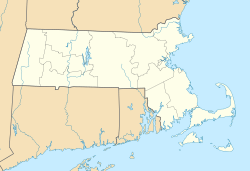Bacon–Morse Historic District facts for kids
Quick facts for kids |
|
|
Bacon–Morse Historic District
|
|

SE corner of North Woodstock and Tipton Rock Roads
|
|
| Location | North Woodstock and Tipton Rock Roads, Southbridge, Massachusetts |
|---|---|
| Area | 100 acres (40 ha) |
| Built | 1789 |
| Architectural style | Greek Revival, Federal |
| MPS | Southbridge MRA |
| NRHP reference No. | 89000602 |
| Added to NRHP | June 22, 1989 |
The Bacon–Morse Historic District is a special old village area in Southbridge, Massachusetts. It includes several historic houses and barns, plus an old cemetery. You can find it where North Woodstock and Tipton Rock Roads meet. The district is named after the Morse and Bacon families, who were some of the first people to settle here. Long ago, there was also a tavern and a schoolhouse in the area, but these buildings are no longer standing. This historic district was added to the National Register of Historic Places in 1989.
Contents
What Makes This Historic District Special?
This district is like a time capsule, showing how rural villages looked long ago. It helps us understand the history of Southbridge and the people who lived there.
Exploring the Historic Homes
The district has several interesting buildings that tell stories of the past.
The Oldest House: Freeman-Pratt Home
One of the most important buildings is the Freeman-Pratt House. It was built around 1750, making it very old! This house is a great example of the Federal style of architecture. It has a special fanlight window above the front door. The door is also framed by decorative columns called pilasters and narrow windows called sidelights. A barn from the 1800s is also still on the property.
Other Unique Houses
Besides the Freeman-Pratt House, there are four other historic homes in the district. Two of them are built in the Greek Revival style, which was popular in the 1800s. Another house shows the Late Victorian style, and the last one was built in 1910. Each house adds to the unique look of the district.
A Look at Morse Cemetery
The Morse Cemetery is another important part of the district. It was officially started in 1789. Experts believe there are more than 200 graves here. Many of these graves are from before 1840, showing just how old this cemetery is.
A Glimpse into the Past: History of the District
This area was first settled in the mid-1700s by families like the Bacons, Morses, and Pratts. By 1830, there were six houses clustered near the main road intersection. A school, which started around 1772, was also in the area. For a long time, the district was mostly farmland. Later, in the late 1800s, a lumber yard was added, bringing some industry to the area.



